Design and Numerical Simulation of the Headworks in the Shizuishan Section of the Yellow River
Abstract
:1. Introduction
2. Materials and Methods
2.1. Introduction to the Study Area
2.2. Mathematical Modelling
2.3. Model Establishment and Parameter Calibration
2.4. Model Validation
3. Results
3.1. Experimental Design
3.1.1. Design for Working Conditions
3.1.2. Scenario Setting
3.1.3. Fish Mouth Flow Field Distribution
3.2. Erosion of Diversion Channels at Different Times
3.3. Erosion of Diversion Channels for Different Scenarios
3.4. Erosion of the Diversion Channel under Different Scenarios at the Same Time
4. Discussion
5. Conclusions
- The fish mouth design utilizes the principle of bend circulation to divide the river into inner and outer channels. The inner channel exhibits higher flow velocity and higher sediment concentration compared to the outer channel, which has lower flow velocity and lower sediment concentration. This design effectively reduces the hydrodynamic conditions and subsequently lowers the sediment-carrying capacity of the water flow.
- Simulation calculations using a one-day time frame reveal that under different scenarios, the maximum sediment accumulation thickness for channel condition 1 is 0.21 m, while channel condition 2 exhibits a maximum sediment accumulation thickness of 0.12 m. These results demonstrate a significant reduction in sediment for channel condition 2.
- As erosion time increases, both channel conditions exhibit sediment accumulation. However, when the calculation time and scenarios are held constant, the sediment accumulation thickness of channel condition 1 consistently exceeds that of channel condition 2.
Author Contributions
Funding
Institutional Review Board Statement
Informed Consent Statement
Data Availability Statement
Acknowledgments
Conflicts of Interest
References
- Goel, A.; Pillai, N.N. A flowmeter for rectangular irrigation field channels. Water Manag. 2008, 161, 135–139. [Google Scholar] [CrossRef]
- Khater, A.; Kitamura, Y.; Shimizu, K.; Abou El Hassan, W.; Fujimaki, H. Quantitative analysis of reusing agricultural water to compensate for water supply deficiencies in the Nile Delta irrigation network. Paddy Water Environ. 2015, 13, 367–378. [Google Scholar] [CrossRef]
- Outeiro, J.C.; Umbrello, D.; M’saoubi, R. Experimental and numerical modelling of the residual stresses induced in orthogonal cutting of AISI 316L steel. Int. J. Mach. Tools Manuf. 2006, 46, 1786–1794. [Google Scholar] [CrossRef]
- Qiao, Q.; Li, C.G.; Jing, H.F.; Huang, L.X.; Yang, C. Impact of an artificial chute cutoff on the river morphology and flow structure in Sipaikou area of the Upper Yellow River. J. Mt. Sci. 2021, 18, 16. [Google Scholar] [CrossRef]
- Surian, N. Downstream variation in grain size along an Alpine river: Analysis of controls and processes. Geomorphology 2002, 43, 137–149. [Google Scholar] [CrossRef]
- Moussavi-Harami, R.; Mahboubi, A.; Khanehbad, M. Analysis of controls on downstream fining along three gravel-bed rivers in the Band-e-Golestan drainage basin NE Iran. Geomorphology 2004, 61, 143–153. [Google Scholar] [CrossRef]
- Bathurst, J.C.; Carling, P.A.; Reid, I.; Walling, D.E.; Webb, B. Sediment Erosion, Transport, and Deposition; Wiley: Hoboken, NJ, USA, 1997. [Google Scholar]
- Petts, G.E.; Gurnell, A.M.; Gerrard, A.J.; Hannah, D.M.; Hansford, B.; Morrissey, I.; Edwards, P.J.; Kollmann, J.; Ward, J.V.; Tockner, K.; et al. Longitudinal variations in exposed riverine sediments: A context for the ecology of the Fiume Tagliamento, Italy. Aquat. Conserv. 2000, 10, 249–266. [Google Scholar] [CrossRef]
- Surian, N. Fluvial Processes in Braided Rivers. In Rivers–Physical, Fluvial and Environmental Processes; Springer: Cham, Switzerland, 2015; pp. 403–425. [Google Scholar]
- Mueller, E.R.; Pitlick, J. Sediment supply and channel mor phology in mountain river systems: 2. Single thread tobraided transitions. J. Geophys. Res. Earth Surf. 2014, 119, 1516–1541. [Google Scholar] [CrossRef]
- Griffiths, G.A. Sediment translation waves in braided gravel-bed rivers. J. Hydraul. Eng. 1993, 119, 924–937. [Google Scholar] [CrossRef]
- Ashmore, P.; Bertoldi, W.; Gardner, J.T. Active width of gravelbed braided rivers. Earth Surf. Process. Landf. 2011, 36, 1510–1521. [Google Scholar] [CrossRef]
- Bagnold, R.A. Bed load transport by natural rivers. Water Resour. Res. 1977, 13, 303–312. [Google Scholar] [CrossRef]
- Chen, G.S.; Wang, Y.M.; Bai, T.; Du, H.H. Diagnoses of runoff-sediment relationship based on variable diagnostic method-variable step length sliding correlation coefficient method in Ning-Meng reach. Int. J. Hydrog. Energy 2016, 41, 15909–15918. [Google Scholar] [CrossRef]
- An, C.; Lu, J.; Qian, Y.; Wu, M.; Xiong, D. The scour-deposition characteristics of sediment fractions in desert aggrading rivers—Taking the upper reaches of the Yellow River as an example. Quat. Int. 2019, 523, 54–66. [Google Scholar] [CrossRef]
- Krishnappan, B.G.; Lau, Y.L. Turbulence Modeling of Flood Plain Flows. J. Hydraul. Eng. 1986, 112, 251–266. [Google Scholar] [CrossRef]
- Li, J.; Fei, L.; Chen, Z.; Sun, X. Jinshan. Particle size distribution and settling velocity of sediments in water diverted from the Yellow River during border-strip irrigation. Tecnol. Cienc. Agua 2017, 8, 31–41. [Google Scholar] [CrossRef]
- Wang, L.; Nie, Z.; Liu, M.; Cao, L.; Zhu, P.; Yuan, Q. Rational Allocation of Water Resources in the Arid Area of Northwestern China Based on Numerical Simulations. Sustainability 2023, 15, 55. [Google Scholar] [CrossRef]
- Kim, B.J.; Hwang, J.H.; Kim, B. FLOW-3D Model Development for the Analysis of the Flow Characteristics of Downstream Hydraulic Structures. Sustainability 2022, 14, 10493. [Google Scholar] [CrossRef]
- Wang, P.; Li, J.; Wang, M.; Hu, J.; Zhang, F. Numerical Simulation of the Hydraulic Characteristics and Fish Habitat of a Natural Continuous Meandering River. Sustainability 2022, 14, 9798. [Google Scholar] [CrossRef]
- Soulis, V.J. Numerical Investigation of the Failure Mechanism of Articulated Aqueduct. J. Perform. Constr. Facil. 2018, 32, 1–17. [Google Scholar] [CrossRef]
- Oyarce, P.; Gurovich, L.; Calderón, I. Simulating Hydraulic Behavior of an Agricultural Drain Based on Experimental Data. J. Irrig. Drain. Eng. 2017, 143, 1–8. [Google Scholar] [CrossRef]
- Alomari, N.K.; Yusuf, B.; Mohammad, T.A.; Ghazali, A.H. Experimental investigation of scour at a channel junctions of different diversion angles and bed width ratios. Catena 2018, 166, 10–20. [Google Scholar] [CrossRef]
- Zheng, X.; Kazemi, E.; Gabreil, E.; Liu, X.; Chen, R. Sustainability of the Dujiangyan Irrigation System for over 2000 Years–A Numerical Investigation of the Water and Sediment Dynamic Diversions. Sustainability 2020, 12, 2431. [Google Scholar] [CrossRef] [Green Version]
- Yan, J.; Chen, M.; Xu, L.; Liu, Q.; Shi, H.; He, N. Mike 21 Model Based Numerical Simulation of the Operation Optimization Scheme of Sedimentation Basin. Coatings 2022, 12, 478. [Google Scholar] [CrossRef]
- Tabuchi, J.P.; Aboulouard, S.; Bernier, J.; Blanchet, B.; Guérin, S.; Saint-Germain, A.; Rocher, V. The Seine river flood in June 2016, implications for the operation of the sanitation system of the heart of Paris region. Tech. —Sci. —Methodes 2019, 114, 67–80. [Google Scholar]
- Sun, J.; Xu, N.; Ding, L.; Ma, Y.; Liu, Z.; Huang, Z. Continuous Expansions of Yangtze River Islands after The Three Gorges Dam tracked by Landsat data based on Google Earth Engine. IEEE Access 2020, 8, 92731–92742. [Google Scholar] [CrossRef]
- Itla, B.; Jcsc, D.; Mla, B. Architecture, sedimentary facies and chronology of a composite island: A model from the Upper Paraná River, Brazil—ScienceDirect. Geomorphology 2020, 372, 107457. [Google Scholar]
- Shi, H.; Cao, Y.; Dong, C.; Xia, C.; Li, C. The Spatio-Temporal Evolution of River Island Based on Landsat Satellite Imagery, Hydrodynamic Numerical Simulation and Observed Data. Remote Sens. 2018, 10, 2046. [Google Scholar] [CrossRef] [Green Version]
- Zhang, S.; Yi, Y.; Liu, Y.; Wang, X. Hydraulic Principles of the 2,268-Year-Old Dujiangyan Project in China. J. Hydraul. Eng. 2013, 139, 538–546. [Google Scholar] [CrossRef]
- Fan, G.; Xia, J.; Song, J.; Sun, H.; Liang, D. Research on application of ecohydrology to disaster prevention and mitigation in China: A review. Water Supply 2022, 22, 2946–2958. [Google Scholar] [CrossRef]
- Gebrehiwot, K.A.; Haile, A.M.; De Fraiture, C.; Chukalla, A.D.; Embaye, T.G. Optimizing flood and sediment management of spate irrigation in Aba’ala Plains. Water Resour. Manag. 2015, 29, 833–847. [Google Scholar] [CrossRef]
- Shanan, L. Runoff, Erosion, and the Sustainability of Ancient Irrigation Systems in the Central Negev Desert. In The Hydrology-Geomorphology Interface: Rainfall, Floods, Sedimentation, Land Use; IAHS Press: Wallingford, UK, 2000; pp. 75–106. [Google Scholar]
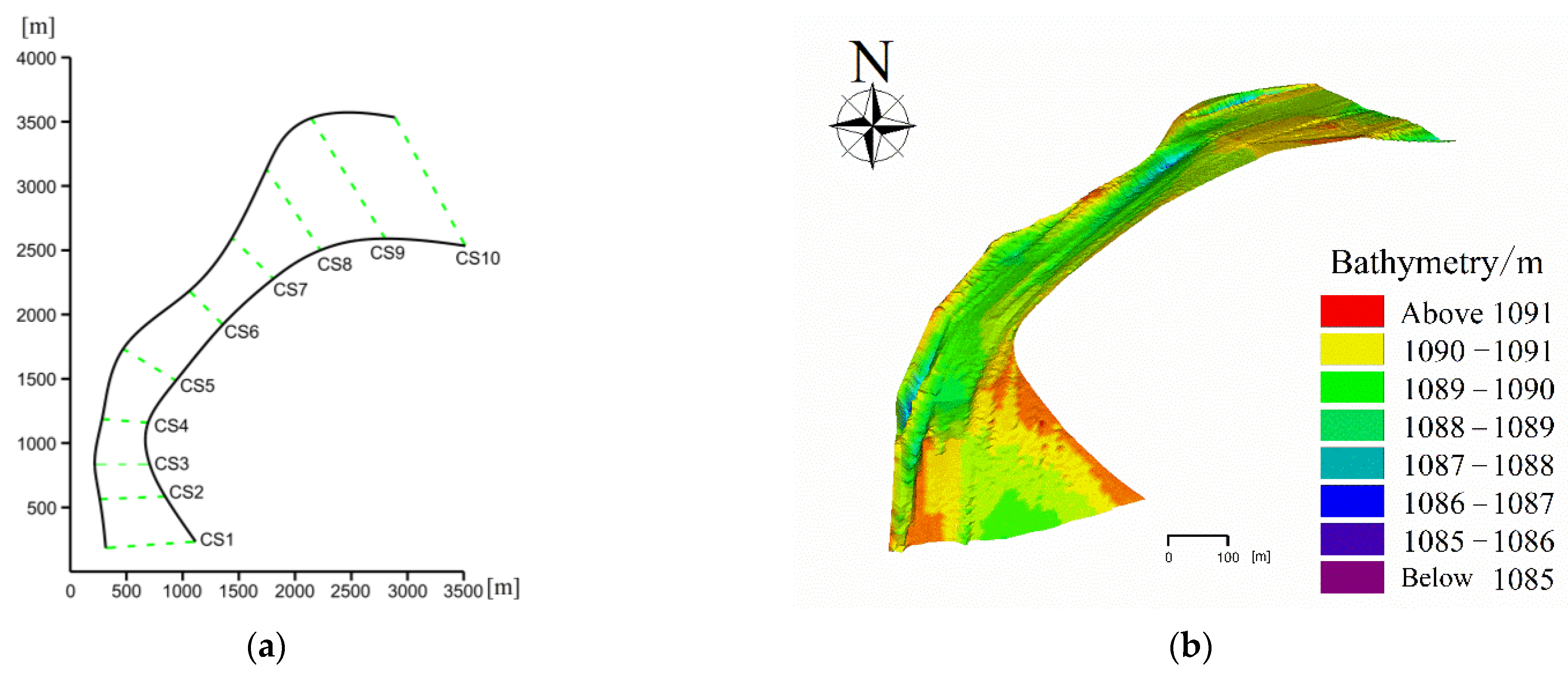
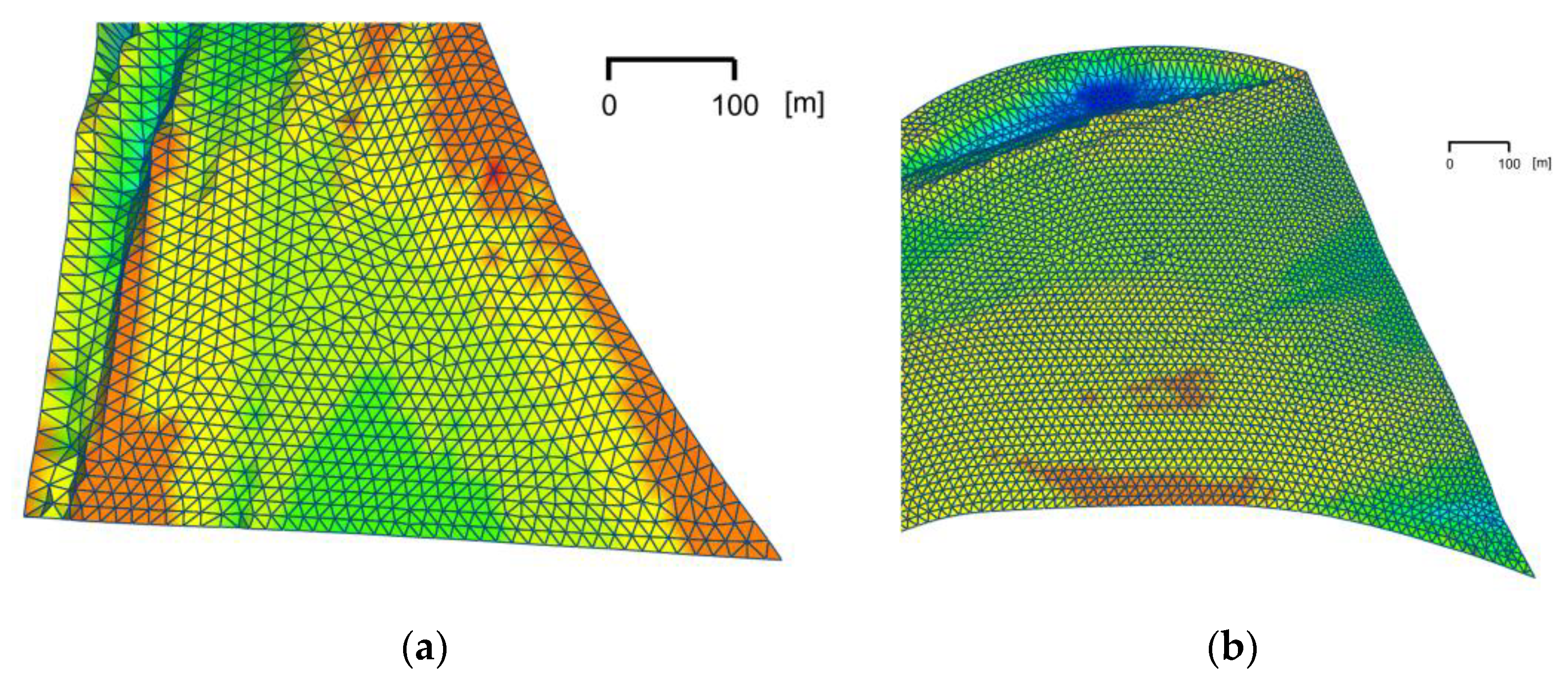


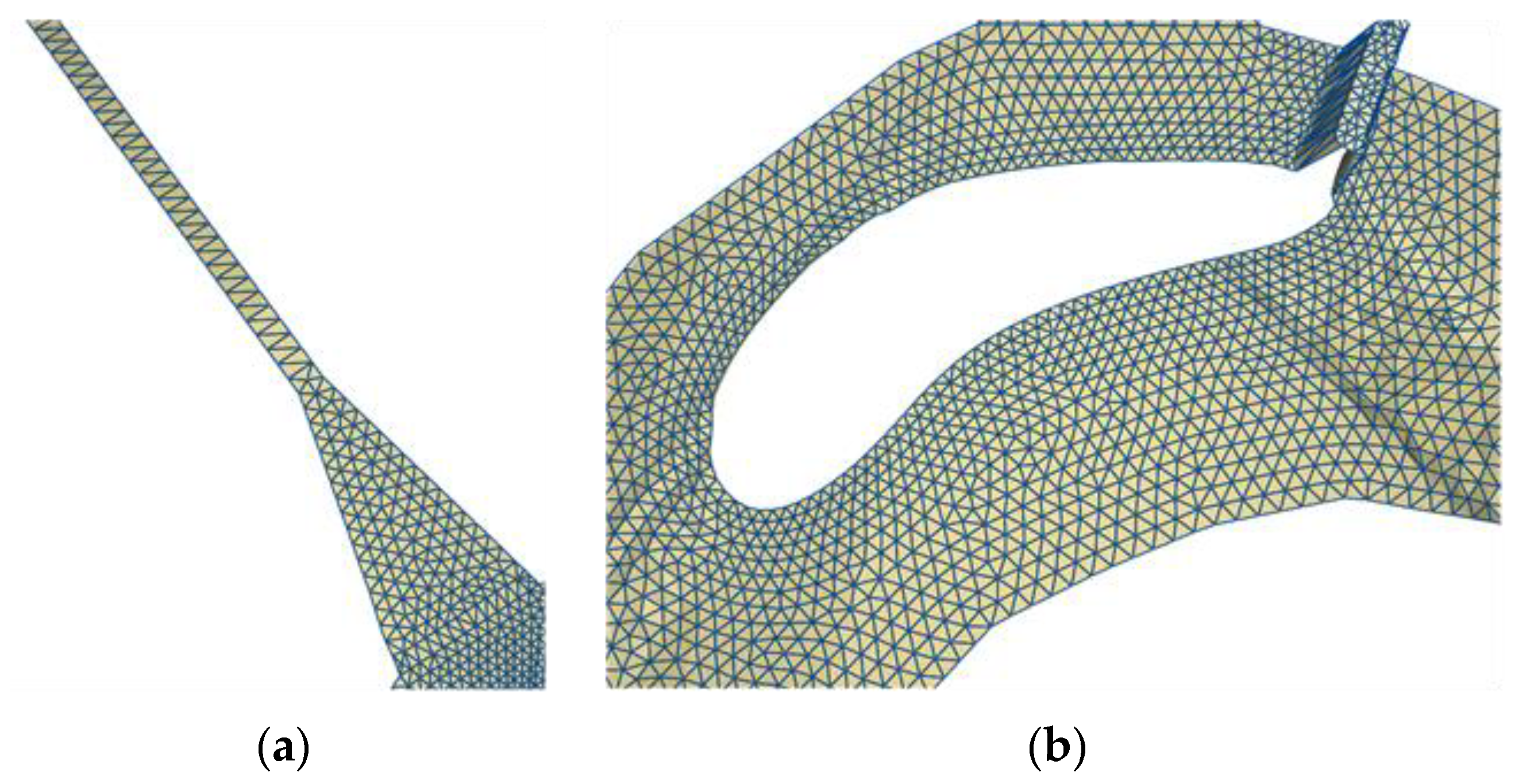
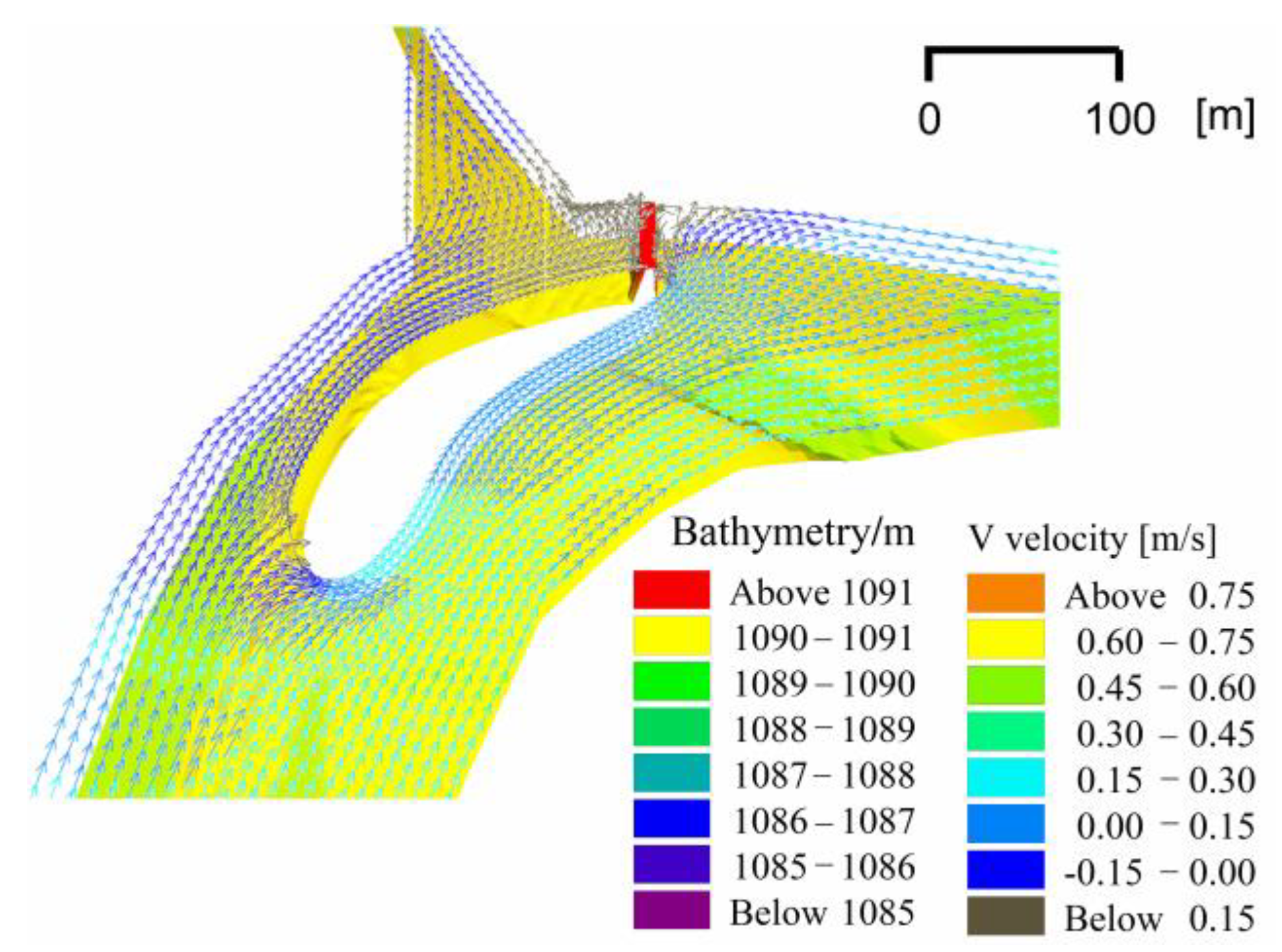
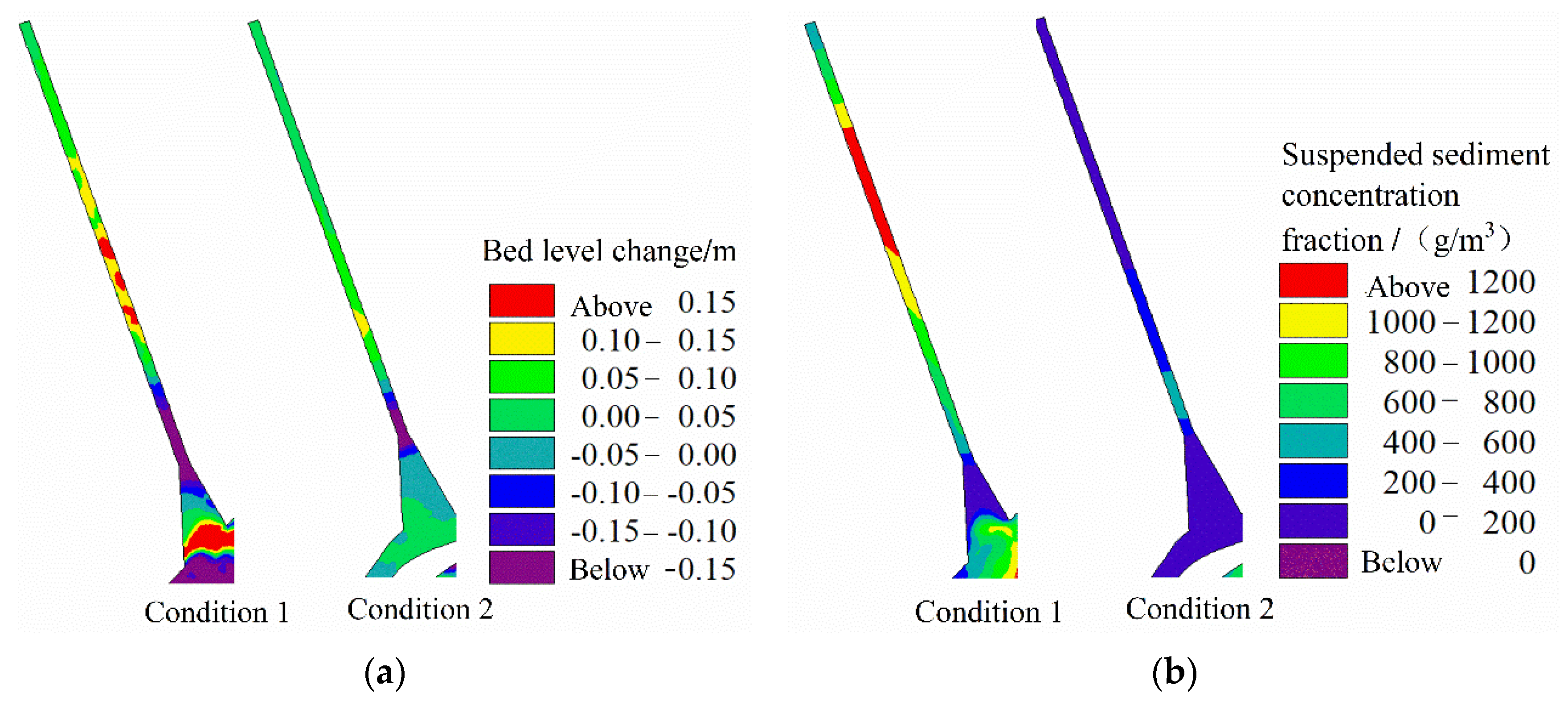



Disclaimer/Publisher’s Note: The statements, opinions and data contained in all publications are solely those of the individual author(s) and contributor(s) and not of MDPI and/or the editor(s). MDPI and/or the editor(s) disclaim responsibility for any injury to people or property resulting from any ideas, methods, instructions or products referred to in the content. |
© 2023 by the authors. Licensee MDPI, Basel, Switzerland. This article is an open access article distributed under the terms and conditions of the Creative Commons Attribution (CC BY) license (https://creativecommons.org/licenses/by/4.0/).
Share and Cite
Liu, M.; Lv, S.; Qiao, Q.; Song, L. Design and Numerical Simulation of the Headworks in the Shizuishan Section of the Yellow River. Sustainability 2023, 15, 4564. https://doi.org/10.3390/su15054564
Liu M, Lv S, Qiao Q, Song L. Design and Numerical Simulation of the Headworks in the Shizuishan Section of the Yellow River. Sustainability. 2023; 15(5):4564. https://doi.org/10.3390/su15054564
Chicago/Turabian StyleLiu, Mingyang, Suiju Lv, Qiao Qiao, and Lulu Song. 2023. "Design and Numerical Simulation of the Headworks in the Shizuishan Section of the Yellow River" Sustainability 15, no. 5: 4564. https://doi.org/10.3390/su15054564
APA StyleLiu, M., Lv, S., Qiao, Q., & Song, L. (2023). Design and Numerical Simulation of the Headworks in the Shizuishan Section of the Yellow River. Sustainability, 15(5), 4564. https://doi.org/10.3390/su15054564








